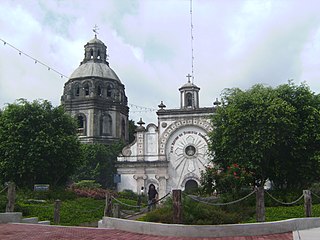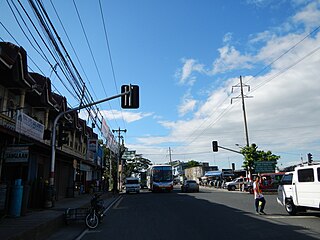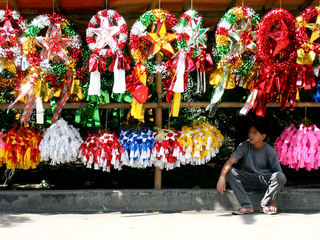
Pampanga, officially the Province of Pampanga, is a province in the Central Luzon region of the Philippines. Lying on the northern shore of Manila Bay, Pampanga is bordered by Tarlac to the north, Nueva Ecija to the northeast, Bulacan to the east, Manila Bay to the central-south, Bataan to the southwest and Zambales to the west. Its capital is the City of San Fernando. Angeles City is the largest LGU, but while geographically within Pampanga, it is classified as a first-class, highly urbanized city and has been governed independently of the province since it received its charter in 1964.

Lubao, officially the Municipality of Lubao, is a 1st class municipality in the province of Pampanga, Philippines. According to the 2020 census, it has a population of 173,502 people.

Candaba, officially the Municipality of Candaba, is a 1st class municipality in the province of Pampanga, Philippines. According to the 2020 census, it has a population of 119,497 people.

San Fernando, officially the City of San Fernando, is a 1st class component city and capital of the province of Pampanga, Philippines. According to the 2020 census, it has a population of 354,666 people.

Bacolor, officially the Municipality of Bacolor, is a 3rd class municipality in the province of Pampanga, Philippines. According to the 2020 census, it has a population of 48,066 people.

Macabebe, officially the Municipality of Macabebe, is a 1st class municipality in the province of Pampanga, Philippines. According to the 2020 census, it has a population of 78,151 people.

Mexico, officially the Municipality of Mexico, is a 1st class municipality in the province of Pampanga, the Philippines. According to the 2020 census, it has a population of 173,403 people. It was also formerly known as Nuevo México during the Spanish period.

Minalin, officially the Municipality of Minalin, is a 4th class municipality in the province of Pampanga, Philippines. According to the 2020 census, it has a population of 48,380 people.

San Simon, officially the Municipality of San Simon, is a 3rd class municipality in the province of Pampanga, Philippines. According to the 2020 census, it has a population of 59,182 people.

Santo Tomas, officially the Municipality of Santo Tomas, is a 4th class municipality in the province of Pampanga, Philippines. According to the 2020 census, it has a population of 42,846 people.

Tarlac City, officially the City of Tarlac, is a 1st class component city and capital of the province of Tarlac, Philippines. According to the 2020 census, it has a population of 385,398 people.

The Giant Lantern Festival is an annual festival held in mid-December in the City of San Fernando in the Philippines. The festival features a competition of giant parol lanterns. Because of the popularity of the festival, the city has been nicknamed the "Christmas Capital of the Philippines".
The Kapampangan people, Pampangueños or Pampangos, are the sixth largest ethnolinguistic group in the Philippines, numbering about 2,784,526 in 2010. They live mainly in the provinces of Pampanga, Bataan and Tarlac, as well as Bulacan, Nueva Ecija and Zambales.

Sisig is a Filipino dish made from pork jowl and ears (maskara), pork belly, and chicken liver, which is usually seasoned with calamansi, onions, and chili peppers. It originates from the Pampanga region in Luzon.

The San Pedro Cutud Lenten Rites is a Holy Week re-enactment of Christ's Passion and Death which takes place in Barangay San Pedro Cutud, City of San Fernando, Pampanga in the Philippines.

A parol is a Filipino ornamental lantern displayed during the Christmas season. Parols are traditionally constructed using bamboo and Japanese paper, and are illuminated with candles, oil lamps, or carbide lamps. Modern parols can be made using other materials such as plastic, metal, and capiz shells and are usually illuminated with electric lighting. Its most-common form is a five-pointed star, although it can come in various shapes and sizes. Large disc-shaped electronic versions of parols produced in Pampanga are known as "parul sampernandu", the phonetic spelling of parol San Fernando, owing to the city where these lanterns are a major product.

Holy Angel University is a private Catholic research university in Angeles City, Philippines. Founded in June 1933 by Don Juan Nepomuceno and Fr. Pedro Paulo Santos, who was later named as the Archbishop of Cáceres, is considered the first lay-founded Catholic school as well as the first co-educational Catholic high school. With a student population of over 21,000, it is the largest private institute of education with the largest student population in a single campus in Central Luzon.

Kapampangan cuisine differed noticeably from that of other groups in the Philippines. The Kapampangan kitchen is the biggest and most widely used room in the traditional Kapampangan household. When the Philippines was under Spanish rule, Spanish friars and sailors taught Kapampangans the basics of Spanish cooking. The Kapampangans were able to produce a unique blend that surprised the Spanish palate. Soon Spanish friars and government officials were entertaining foreign guests at the expense of Kapampangan households. In the late 18th century, the Arnedo clan of Apalit were commissioned by the colonial government to entertain foreign dignitaries that included a Cambodian prince and a Russian archduke. Kapampangans were given the task of creating the meal and menu that was served in the proclamation of the First Philippine Republic in Malolos, Bulacan.

Ancestral houses of the Philippines or Heritage Houses are homes owned and preserved by the same family for several generations as part of the Filipino family culture. It corresponds to long tradition by Filipino people of giving reverence for ancestors and elders. Houses could be a simple house to a mansion. The most common ones are the "Bahay na Bato". Some houses of prominent families had become points of interest or museums in their community because of its cultural, architectural or historical significance. These houses that are deemed of significant importance to the Filipino culture are declared Heritage House by the National Historical Commission of the Philippines (NHCP), previously known as the National Historical Institute (NHI) of the Philippines. Preservation is of utmost importance as some ancestral houses have come into danger due to business people who buy old houses in the provinces, dismantle them then sell the parts as ancestral building materials for homeowners wishing to have the ancestral ambiance on their houses. These ancestral houses provide the current generation a look back of the country's colonial past through these old houses.
Pampanga in the Philippine Revolution remained almost wholly loyal to Spanish suzerainty, with only few noble Kapampangan families defecting to the Katipunan. Kapampangan involvement in defending Spanish interests began when the Revolution broke out, with many freemen enlisting in Spanish forces. However, Tagalog rebels would eventually infiltrate the province and begin a campaign of terrorism. Once Spain lost the Battle of Manila Bay, Spanish forces in Pampanga retreated to Macabebe and awaited their return to Spain. Republican forces would raze and loot Kapampangan towns for their cooperation with Spanish forces. To revenge their losses, many Kapampangans would enlist with the Americans to defeat the Philippine Republic.

















